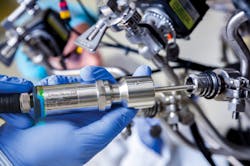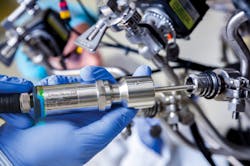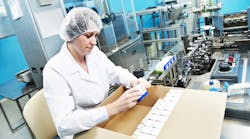There’s no question that pharma products have become more sophisticated in recent years — from tissue engineered medicines to targeted gene therapies. But despite these advances, many parts of the manufacturing process are still in need of a technology-driven upgrade.
“Modern technology enables timely delivery of information to the shop floor to meet the requirements of innovative therapies like precision medicines, which requires a new level of agility in manufacturing,” says Mike Jovanis, vice president of quality at Veeva Systems.
From increased connectivity throughout operations to better data analysis and automation tools, vendors have innovated solutions to transform every stage of production.
Ditching the paper trail
There’s no speedier way to send information than with the touch of a button. Yet, companies continue to drown in paper-based systems that leave more room for error and hinder useful analysis.
“The content on the manufacturing floor is most often accessed through paper binders or custom applications,” Jovanis says. “Without digital distribution of documents, videos, procedures, and work instructions, it is hard to keep pace with frequent updates and changes.”
Veeva’s new Vault Station Manager provides a unified suite of cloud-based quality applications in one handy mobile application. According to Jovanis, Vault Station Manager synchronizes three applications — Vault QualityDocs, Vault QMS and Vault Training — so that administrators can centrally manage, distribute, and track the content being used at each facility, station, or device. Using this approach gives organizations complete visibility into the documents and videos manufacturing teams are leveraging for improved efficiency and reduced compliance risk.
“Cloud applications designed specifically for pharmaceutical manufacturing, for instance, run on mobile devices and support manufacturing processes with up-to-date content. Ultimately, a digitally connected shop floor enables increased efficiency and collaboration that is crucial in today’s environment,” he says.
Endress+Hauser’s iTHERM TrustSens is the world’s first self-calibrating RTD.
MasterControl’s new Manufacturing Excellence solution is also geared towards transitioning companies from paper-based operations — in this case, with batch records — to a fully digitized process.
“When manufacturers have a paper or hybrid process, data becomes trapped in the paper or siloed in disconnected applications, making it harder to see the trends,” explains Matt Lowe, executive vice president for MasterControl. “You can certainly capture data in any environment, even in spreadsheets, but unless you have a system that allows you to organize it, query it, track it, trend it and predict on it, it’s of minimal use in preventing a problem.”
According to the company, the Manufacturing Excellence solution includes several tools that help streamline and maintain orderly master batch and batch production records, manage recipe changes and substitutions, automate equipment calibration, and manage equipment maintenance. The solution not only helps eliminate errors, it also gives manufacturers a way to better analyze data.
“This leads to the biggest benefit — leveraging big data, where all the data is there and connected. In this environment, companies can see trends, make predictions and understand how to stop quality events, and create huge time efficiencies,” Lowe says.
Making temperature control automatic
Automation technology has also transformed temperature control — a vital aspect of manufacturing sensitive pharma products.
“Critical processes in the life sciences and other process industries often require frequent calibration of temperature instrumentation,” explains Keith Riley, national product manager, Pressure and Temperature, Endress+Hauser.
The iTHERM TrustSens made by Endress+Hauser is the world’s first self-calibrating resistance temperature detector, and was designed to help make frequent temperature calibration a thing of the past.
“Recent developments in temperature sensor technology now make it possible for a sensor to perform in-situ calibration, reducing downtime and the risk associated with traditional calibration cycles,” Riley says.
The company says that the iTHERM TrustSens provides seamless compliance with FDA and GMP standards and eliminates the risk of undetected non-conformities.
SpotSee, supply chain and transportation monitoring specialists, have also innovated a temperature monitoring product designed for shipping — the critical last phase of pharma manufacturing.
“The last mile of the pharmaceutical supply chain process is the most complicated step because delivery methods vary and control is limited,” explains Angela Kerr, vice president, product portfolio, SpotSee “Whether a shipment is delivered to a home, small pharmacy or medical office, temperature-sensitive products left on a front porch or loading bay in a Dallas summer or a Chicago winter can be a challenge. How long did it sit there? Did the packaging withstand the extreme temperature? How can the recipient be sure the product maintained its efficacy?”
According to Kerr, SpotSee’s Cold Chain Complete was created in response to these challenges. As a combination of SpotSee’s acending and descending indicators, Cold Chain Complete enables companies to monitor last-mile deliveries for both hot and cold excursions.
“It was designed as a single-use, easy-to-read option for pharmaceutical manufacturers,” Kerr says.
From plant floor operations to tracking products after they’ve left the door, pharma manufacturing continues to be transformed by digital and automation tools.







